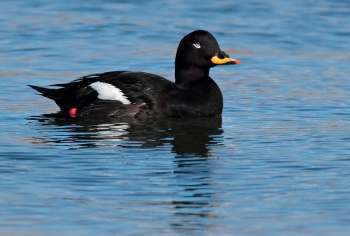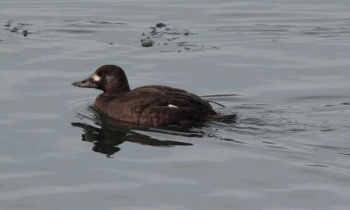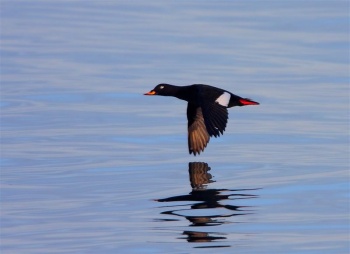(Imp sizes. References updated) |
(work in progress) |
||
| Line 1: | Line 1: | ||
| − | [[Image: | + | [[Image:Velvet_Scoter.jpg|thumb|450px|right|Male ''M. f. deglandi'' <br />Photo © by {{user|digitalbirder|digitalbirder}}<br />White Rock, [[British Columbia]], [[Canada]], February 2005]] |
| − | ;[[:Category:Melanitta|Melanitta]] | + | ;[[:Category:Melanitta|Melanitta]] deglandi |
| − | |||
==Identification== | ==Identification== | ||
| − | [[Image: | + | [[Image:Scooter bf.jpg|thumb|350px|right|Male '''Siberian Scoter''' ''M. f. stejnegeri''<br />Photo © by {{user|DaninJapan|DaninJapan}}<br />Misawa port, Aomori-Ken, [[Japan]], March 2006]] |
Length 51-58cm (20-22¾ in), weight 1200-1800 g<br /> | Length 51-58cm (20-22¾ in), weight 1200-1800 g<br /> | ||
'''Male''' | '''Male''' | ||
| Line 16: | Line 15: | ||
*Two pale spots in the head, one on the [[Topography#Heads|auriculars]], one between eye and bill<br /> | *Two pale spots in the head, one on the [[Topography#Heads|auriculars]], one between eye and bill<br /> | ||
'''Juvenile''' a paler version of female | '''Juvenile''' a paler version of female | ||
| + | ====Notes on distinguishing males of White-winged and [[Velvet Scoter]]==== | ||
| + | [[Image:Velvet Scoter, western Sweden.jpg|thumb|350px|right|Velvet Scoter with wing part-open showing the white secondaries<br />Photo by {{user|Digiscoper321|Digiscoper321}}<br />Western [[Sweden]], April 2015]] | ||
| + | *''M. fusca'': the least knob on the bill, and the least white around and behind the eye; almost no white above the eye. The coloured section of the bill is yellow and relatively long, and the distance from the base of that to the eye is short, producing the impression that the eye is positioned relatively far forward on the head. The crown looks highest above the eye. | ||
| + | *''M. d. deglandi'': clear knob at the base of the bill, with the yellow-orange part relatively short, so that the eye looks set further back on head than ''M. f. fusca''. The white around the eye is shaped as a checkmark, pointed up at the rear end. The coloured part of the bill is orange with the top parts looking yellow. The crown is highest in front of the eye. When seen well, flanks will be brown in contrast to black back and breast. | ||
| + | *''M. d stejnegeri'': Head shape closer to [[Common Eider]] in shape, with a long, sloping forehead. White around eye similar to or longer than ''M. f. deglandi''. It has a clear knob - almost like a small Rhinoceros horn - on the bill, further forward than ''M. f. deglandi'', and the coloured parts are mostly red with yellow "lipstick" below. Flanks are black | ||
| + | |||
| + | Females are much harder to distinguish, only determinable at the closest range; ''M. fusca'' has a slightly concave forehead with no basal swelling on the bill, ''M. d stejnegeri'' a slightly swollen bill base, and ''M. d. deglandi'' a marginally more swollen bill base. | ||
====Flight==== | ====Flight==== | ||
In flight, it shows a white patch on the rear of the wing. | In flight, it shows a white patch on the rear of the wing. | ||
==Distribution== | ==Distribution== | ||
| − | |||
Breeds in northern areas around the globe, such as [[Scandinavia]] (especially [[Sweden]] and [[Norway]]), northern [[Asia]], and northern [[North America]]. | Breeds in northern areas around the globe, such as [[Scandinavia]] (especially [[Sweden]] and [[Norway]]), northern [[Asia]], and northern [[North America]]. | ||
| Line 25: | Line 30: | ||
==Taxonomy== | ==Taxonomy== | ||
====Subspecies==== | ====Subspecies==== | ||
| − | + | Two subspecies are currently recognised<sup>[[#References|[1]]]</sup>, split into two species by several authorities<sup>[[#References|[2]]]</sup><sup>[[#References|[3]]]</sup>: | |
*''M. f. fusca'' ('''Velvet Scoter''') is found in [[Europe]] and western [[Asia]]. | *''M. f. fusca'' ('''Velvet Scoter''') is found in [[Europe]] and western [[Asia]]. | ||
*''M. f. deglandi'' ('''White-winged Scoter''') occurs in [[North America]] and includes ''M. f. dixoni'' which is no longer recognised. | *''M. f. deglandi'' ('''White-winged Scoter''') occurs in [[North America]] and includes ''M. f. dixoni'' which is no longer recognised. | ||
*''M. f. stejnegeri'' ('''Siberian Scoter''') is found in Eastern [[Asia]]. This form is also sometimes proposed for recognition as a full species<sup>[[#References|[4]]]</sup>. | *''M. f. stejnegeri'' ('''Siberian Scoter''') is found in Eastern [[Asia]]. This form is also sometimes proposed for recognition as a full species<sup>[[#References|[4]]]</sup>. | ||
''M. f. deglandi'' has in the past and is increasingly again recognised as a full species (for example by the British BOURC<sup>[[#References|[3]]]</sup>), which would keep the name of White-winged Scoter; subspecies ''M. f. fusca'' being Velvet Scoter. The subspecies ''M. f. stejnegeri'' is a subspecies of ''M. deglandi'' if IOC<sup>[[#References|[2]]]</sup> or BOURC<sup>[[#References|[3]]]</sup> is followed, but is also considered a full species, ''M. stejnegeri'' by BirdLife<sup>[[#References|[4]]]. | ''M. f. deglandi'' has in the past and is increasingly again recognised as a full species (for example by the British BOURC<sup>[[#References|[3]]]</sup>), which would keep the name of White-winged Scoter; subspecies ''M. f. fusca'' being Velvet Scoter. The subspecies ''M. f. stejnegeri'' is a subspecies of ''M. deglandi'' if IOC<sup>[[#References|[2]]]</sup> or BOURC<sup>[[#References|[3]]]</sup> is followed, but is also considered a full species, ''M. stejnegeri'' by BirdLife<sup>[[#References|[4]]]. | ||
| − | |||
| − | |||
| − | |||
| − | |||
| − | |||
| − | |||
| − | |||
| − | |||
| − | |||
| − | |||
==Habitat== | ==Habitat== | ||
| Line 59: | Line 54: | ||
''[[Media:Melanitta fusca (song).mp3|Listen in an external program]]'' | ''[[Media:Melanitta fusca (song).mp3|Listen in an external program]]'' | ||
==References== | ==References== | ||
| − | #{{Ref- | + | #{{Ref-Clements6thAug18}}#{{Ref-GillDonsker14V5.2}}#[http://www.bou.org.uk/recbrlst.html DUDLEY et al.] 2006. The British List: A Checklist of Birds of Britain (7th edition). Ibis 148:526–563 with online updates to 2009 |
#Handbook of the Birds of the World Alive: [http://www.hbw.com/species/siberian-scoter-melanitta-stejnegeri Siberian Scoter] (retrieved May 2015) | #Handbook of the Birds of the World Alive: [http://www.hbw.com/species/siberian-scoter-melanitta-stejnegeri Siberian Scoter] (retrieved May 2015) | ||
#R Strack 2010. Fløjlsænder. ''Fugle i Felten'' 1: 6-7, January 2010 (in Danish) . | #R Strack 2010. Fløjlsænder. ''Fugle i Felten'' 1: 6-7, January 2010 (in Danish) . | ||
Revision as of 11:21, 28 August 2018
- Melanitta deglandi
Identification

Photo © by DaninJapan
Misawa port, Aomori-Ken, Japan, March 2006
Length 51-58cm (20-22¾ in), weight 1200-1800 g
Male
- Black overall plumage
- White 'tick' just below and behind the eye
- Long yellow bill
- Thick neck
- Pointed tail
Female
- Dusky brown upperparts
- Scaly-looking brownish-grey underparts
- Two pale spots in the head, one on the auriculars, one between eye and bill
Juvenile a paler version of female
Notes on distinguishing males of White-winged and Velvet Scoter

Photo by Digiscoper321
Western Sweden, April 2015
- M. fusca: the least knob on the bill, and the least white around and behind the eye; almost no white above the eye. The coloured section of the bill is yellow and relatively long, and the distance from the base of that to the eye is short, producing the impression that the eye is positioned relatively far forward on the head. The crown looks highest above the eye.
- M. d. deglandi: clear knob at the base of the bill, with the yellow-orange part relatively short, so that the eye looks set further back on head than M. f. fusca. The white around the eye is shaped as a checkmark, pointed up at the rear end. The coloured part of the bill is orange with the top parts looking yellow. The crown is highest in front of the eye. When seen well, flanks will be brown in contrast to black back and breast.
- M. d stejnegeri: Head shape closer to Common Eider in shape, with a long, sloping forehead. White around eye similar to or longer than M. f. deglandi. It has a clear knob - almost like a small Rhinoceros horn - on the bill, further forward than M. f. deglandi, and the coloured parts are mostly red with yellow "lipstick" below. Flanks are black
Females are much harder to distinguish, only determinable at the closest range; M. fusca has a slightly concave forehead with no basal swelling on the bill, M. d stejnegeri a slightly swollen bill base, and M. d. deglandi a marginally more swollen bill base.
Flight
In flight, it shows a white patch on the rear of the wing.
Distribution
Breeds in northern areas around the globe, such as Scandinavia (especially Sweden and Norway), northern Asia, and northern North America.
Migrates in winter to areas that have coastal open water, for example in Europe will be found from Norway to Spain and east to the Caspian Sea.
Taxonomy
Subspecies
Two subspecies are currently recognised[1], split into two species by several authorities[2][3]:
- M. f. fusca (Velvet Scoter) is found in Europe and western Asia.
- M. f. deglandi (White-winged Scoter) occurs in North America and includes M. f. dixoni which is no longer recognised.
- M. f. stejnegeri (Siberian Scoter) is found in Eastern Asia. This form is also sometimes proposed for recognition as a full species[4].
M. f. deglandi has in the past and is increasingly again recognised as a full species (for example by the British BOURC[3]), which would keep the name of White-winged Scoter; subspecies M. f. fusca being Velvet Scoter. The subspecies M. f. stejnegeri is a subspecies of M. deglandi if IOC[2] or BOURC[3] is followed, but is also considered a full species, M. stejnegeri by BirdLife[4].
Habitat
Breeds around fresh water bodies near boreal forests and arctic tundra; sometimes far from the coast.
Outside of the breeding season, they are to be found in coastal waters, often near shellfish beds
Behaviour
M. f. fusca often mixes with with Common Eider, and sometimes with Common Scoter.
Action
Slower and more powerful than Common Scoter.
Diet
Their diet includes shellfish, crabs, sea urchins, fish, insect larvae and plants.
Breeding
They build a lined nest on the ground near lakes or rivers, in woodland or tundra. The clutch consists of 7-9 eggs.
Vocalisation
<flashmp3>Melanitta fusca (song).mp3</flashmp3>
Listen in an external program
References
- Clements, J. F., T. S. Schulenberg, M. J. Iliff, D. Roberson, T. A. Fredericks, B. L. Sullivan, and C. L. Wood. 2018. The eBird/Clements checklist of birds of the world: v2018. Downloaded from http://www.birds.cornell.edu/clementschecklist/download/
- Gill, F and D Donsker (Eds). 2015. IOC World Bird Names (version 5.2). Available at http://www.worldbirdnames.org/.
- DUDLEY et al. 2006. The British List: A Checklist of Birds of Britain (7th edition). Ibis 148:526–563 with online updates to 2009
- Handbook of the Birds of the World Alive: Siberian Scoter (retrieved May 2015)
- R Strack 2010. Fløjlsænder. Fugle i Felten 1: 6-7, January 2010 (in Danish) .
- Birdweb.org
- Collins Bird Guide ISBN 0 00 219728
- Collins Field Guide 5th Edition ISBN 0 00 219900 9
Recommended Citation
- BirdForum Opus contributors. (2024) White-winged Scoter. In: BirdForum, the forum for wild birds and birding. Retrieved 27 April 2024 from https://www.birdforum.net/opus/White-winged_Scoter






